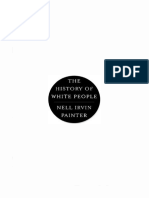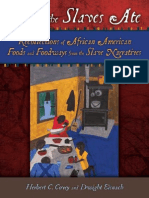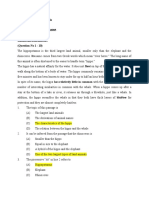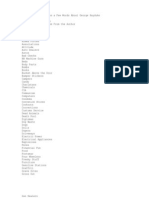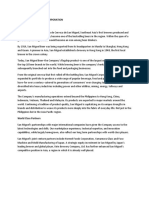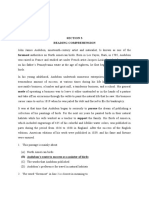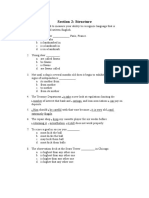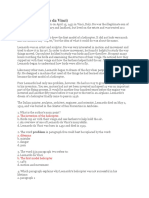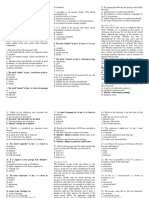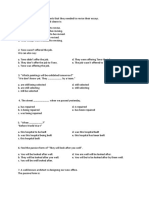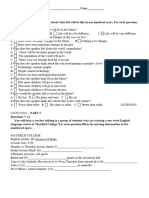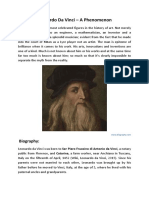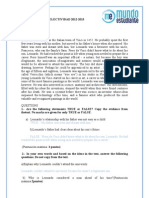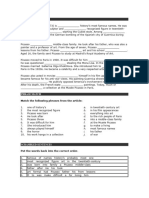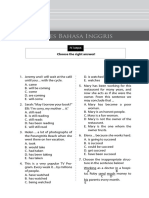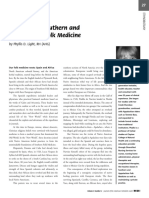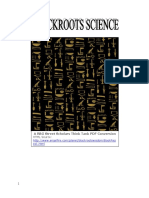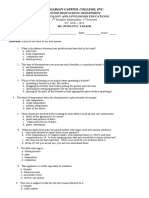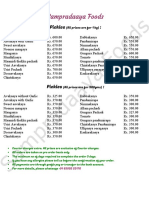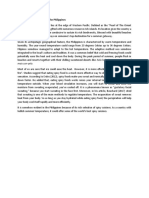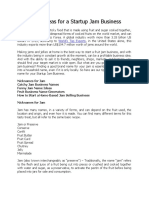Latihan B.ing Rading
Uploaded by
Ali Akbar RafsanLatihan B.ing Rading
Uploaded by
Ali Akbar RafsanBIMBEL POLISI VIRTUAL +62 8820-0523-2270 @bimbel.polisi.
virtual
8TH MEETING
READING : BIOGRAPHY
TEXT 1
John James Audubon, nineteenth-century artist and naturalist, is known as one of the
foremost authorities on North American birds. Born in Les Cayes, Haiti, in 1785, Audubon
was raised in Pennsylvania estate at the age of eighteen; he first began to study and paint
birds.
In his young adulthood, Audubon undertook numerous enterprises, generally without a
tremendous amount of success; at various times during his life he was involved in a
mercantile business, a lumber and grist mill, a taxidermy business, and a school. His
general mode of operating a business was to leave it either unattended or in the hands of a
partner and take off on excursions through the wilds to paint the natural life that he saw.
His business career came to end in 1819 when he was jailed for debt and forced to file for
bankruptcy.
It was at that time that Audubon began seriously to pursue the dream of publishing a
collection of his paintings of birds. For the next six years he painted birds in their natural
habitats while his wife worked as a teacher to support the family. His Birds of America,
which included engravings of 435 of his colorful and lifelike water colors, was published
in parts during the period from 1826 to 1838 in England. After the success of the English
editions, American editions of his work were published in 1839, and his fame and fortune
were ensured.
1. This passage is mainly talking about…
a. North American birds
b. Audubon’s route to success as a painter of birds
c. The works that Audubon published
d. Audubon’s preference for travel in natural habitats
2. The word “foremost” in the first sentence is closest in meaning to…
a. Prior
b. Leading
c. First
d. Largest
3. In the second paragraph, the author mainly discusses…
a. How Audubon developed his painting style
b. Audubon’s involvement in a mercantile business
c. Where Audubon went on his excursions
d. Audubon’s unsuccessful business practices
BAHASA INGGRIS – AKPOL 43
BIMBEL POLISI VIRTUAL +62 8820-0523-2270 @bimbel.polisi.virtual
4. The word “mode” in the second paragraph could best be replaced by…
a. Method
b. Vogue
c. Average
d. Trend
5. Audubon decided not to continue to pursue business when…
a. He was injured in an accident at a grist mill
b. He decided to study art in France
c. He was put in prison because he owed money
d. He made enough money from his paintings
6. The word “pursue” in the 1st sentence of the 3rd paragraph is closest in meaning to…
a. Imagine
b. Share
c. Follow
d. Deny
7. According to the passage, Audubon’s paintings…
a. Were realistic portrayals
b. Used only black, white, and gray
c. Were done in oils
d. Depicted birds in cages
8. The word “support” in the last paragraph could best be replaced by…
a. Tolerate
b. Provide for
c. Side with
d. Fight for
9. It can be inferred from the passage that after 1839 Audubon…
a. Unsuccessfully tried to develop new business
b. Continued to be supported by his wife
c. Traveled to Europe
d. Became wealthy
BAHASA INGGRIS – AKPOL 44
BIMBEL POLISI VIRTUAL +62 8820-0523-2270 @bimbel.polisi.virtual
TEXT 2
Leonardo da Vinci was born on April 15, 1452 in Vinci, Italy. He was the illegitimate
son of Ser Piero, a Florentine notary and landlord, but lived on the estate and was treated
as a legitimate son.
In 1483, Leonardo da Vinci drew the first model of a helicopter. It did not look very
much like our modern day “copter,” but the idea of what it could do was about the same.
Leonardo was an artist and sculptor. He was very interested in motion and movement and
tried to show it in his art. In order to show movement, he found it helpful to study the way
things moved. One subject he liked to study was birds and how they flew. He spent many
hours watching the birds and examining the structure of their wings. He noticed how they
cupped air with their wings and how the feathers helped hold the air. Through these
studies, Leonardo began to understand how birds were able to fly.
Like many other men, Leonardo began to dream of the day when people would be able
to fly. He designed a machine that used all the things he had learned about flight, and thus
became the first model of a helicopter.
Poor Leonardo had only one problem, however. He had no way to give the necessary
speed to his invention. You see, motors had not yet been invented and speed 19 was an
important part of the flying process. It would be another four hundred years before the
engine was invented and another fifty years before it was put to the test in an airplane.
Leonardo’s dream of a helicopter finally came to pass in 1936.
The Italian painter, sculptor, architect, engineer, and scientist, Leonardo died on May 2,
1519, and was buried in the cloister of San Fiorentino in Amboise.
10. What is the author’s main point?
a. The invention of the helicopter.
b. Birds cup air with their wings and use feathers to help hold the air.
c. An overview of one of Leonardo da Vinci’s many skills.
d. Leonardo da Vinci was born in 1452 and died in 1519.
11. The word problem in paragraph five could best be replaced by the word…
a. dilemma
b. mistake
c. danger
d. pain
12. The word it in paragraph two refers to…
a. Leonardo da Vinci
b. The first model helicopter
c. 1483
d. motion and movement
BAHASA INGGRIS – AKPOL 45
BIMBEL POLISI VIRTUAL +62 8820-0523-2270 @bimbel.polisi.virtual
13. Which paragraph explains why Leonardo’s helicopter was not successful in his
lifetime?
a. paragraph 1
b. paragraph 2
c. paragraph 4
d. paragraph 5
14. The word illegitimate in paragraph one is closest in meaning to…
a. against the law or illegal
b. not in correct usage
c. incorrectly deduced; illogical
d. born out of wedlock
15. The following sentence would best complete which paragraph? “Since then people
have been living out Leonardo’s dream of flying.”
a. paragraph 3
b. paragraph 4
c. paragraph 5
d. paragraph 2
16. What was the main problem with Leonardo’s invention?
a. motors were not yet invented
b. the birds lost their feathers
c. he was illegitimate
d. he couldn’t draw
17. The word they in the third paragraph refers to…
a. the feathers
b. the birds
c. the studies
d. the wings
18. In what year was the first helicopter flown?
a. 1483
b. 1452
c. 1519
d. 1936
19. What two things did birds have that Leonardo da Vinci noticed helped them to fly?
a. wings and beaks
b. feathers and talons
c. wings and feathers
d. cups and feathers
BAHASA INGGRIS – AKPOL 46
BIMBEL POLISI VIRTUAL +62 8820-0523-2270 @bimbel.polisi.virtual
20. The word thus in the fourth paragraph could best be replaced by…
a. Hence
b. After
c. Unsuitably
d. Inappropriately
TEXT 3
The next artist in this survey of American artist is James Whistler; he is included in
this survey of American artist because he was born in the United States, although the
majority of his artwork was completed in Europe. Whistler was born in Massachusetts in
1834, but nine years later his father moved the family to St. Petersburg, Russia, to work on
the construction of a railroad. The family returned to the United States in 1849. Two years
later Whistler entered the U.S. military academy at West Point, but he was unable to
graduate. At the age of twenty-one Whistler went to Europe to study art despite familial
objections, and he remained in Europe until his death.
Whistler worked in various art forms, including etchings and lithographs. However, he
is most famous for his paintings, particularly Arrangement in Gray and Black No. 1:
Portrait of the Artist’s Mother or Whistler’s Mother, as it is more commonly known. This
painting shows a side view of Whistler’s mother, dressed I black and posing against a gray
wall. The asymmetrical nature of the portrait, with his mother seated off-center, is highly
characteristic of Whistler’s work.
21. The paragraph preceding this passage most likely discusses…
a. A survey of eighteenth-century art
b. a different American artist
c. Whistler’s other famous paintings
d. European artists
22. Which of the following best describes the information in the passage?
a. Several artists are presented
b. One artist’s life and works are described
c. Various paintings are contrasted
d. Whistler’s family life is outlined
23. Whistler is considered an American artist because…
a. he was born in America
b. he spent most of his life in Americat
c. he served in the U.S. military
d. he created most of his famous art in America
BAHASA INGGRIS – AKPOL 47
BIMBEL POLISI VIRTUAL +62 8820-0523-2270 @bimbel.polisi.virtual
24. The world “majority” in line 2 is closest in meaning to…
a. seniority
b. maturity
c. large pices
d. high percentage
25. It is implied in the passage that Whistler’s family was…
a. unable to find any work at all in Rusia
b. highly supportive of his desire to pursue art
c. working class
d. military
26. The word “objections” in line 7 is closest in meaning to…
a. protests
b. goals
c. agreements
d. battles
27. In line 8, the “etchings” are…
a. a type of painting
b. the same as a lithograph
c. an art form introduced by Whistler
d. an art form involving engraving
28. The word “asymmetrical” in line 11 is closest in meaning to…
a. proportionate
b. uneven
c. balanced
d. lyrical
29. Which of the following is NOT true according to the passage?
a. Whistler work with a variety of art forms.
b. Whistler’s Mother is not the official name of his painting.
c. Whistler is best known for his etchings.
d. Whistler’s Mother is painted in somber tones.
30. Where in the passage does the author mention the types of artwork that Whistler was
involved in?
a. Lines 1-3
b. Lines 4-5
c. Lines 6-7
d. Lines 8-10
BAHASA INGGRIS – AKPOL 48
BIMBEL POLISI VIRTUAL +62 8820-0523-2270 @bimbel.polisi.virtual
Reading comprehension No. 1-10
While the bald eagle is one national symbol of the United States, it is not the only one.
Uncle Sam, the bearded gentleman costumed in the red, white, and blue stars and stripes of
the nation's flag, is another well-known national symbol. According to legend, this
character is based on Samuel Wilson, the owner of a meat packing business in Troy, New
York. During the War of 1812, Sam Wilson's company was granted a government contract
to supply meat to the nation's soldiers; this meat was supplied to the army in barrels
stamped with the initials U.S., which stood for United States. However, the country was at
that time relatively young, and the initials U.S. were not commonly used. Many people
questioned what the initials represented, and the standard reply became "Uncle Sam", for
the owner of the barrels. It is now generally accepted that the figure of Uncle Sam is based
on Samuel Wilson, and the U.S. Congress has made it official by adopting a resolution
naming Samuel Wilson as the inspiration for Uncle Sam.
1. Uncle Sam-Symbols of the Nation. The paragraph preceding this passage most probably
discusses...
a. the war of 1812
b. the bald eagle, which symbolizes mthe United States.
c. Sam Wilson's meat-packing company.
d. the costume worn by Uncle Sam.
2. Which of the following is the most appropriate title for this passage?
a. The Bald Eagle.
b. The symbols of the United States.
c. Samuel Wilson
d. Uncle Sam-Symbols of the Nation.
3. Which of the following is not mentioned about Uncle Sam's appearance?
a. He wears facial hair
b. The is some blue in his clothing
c. He is bald.
d. His clothes have stripes in them.
4. The word "costumed" in line 2 could most easily be replaced by
a. dressed
b. nationalized
c. hidden
d. seen
BAHASA INGGRIS – AKPOL 49
BIMBEL POLISI VIRTUAL +62 8820-0523-2270 @bimbel.polisi.virtual
5. Sam Wilson was the proprietor of what type of business?
a. A costume company
b. A meat-packing company.
c. A military clothier.
d. A barrel-making company.
6. The word “granted', in line 5 means...
a. Refused.
b. Underbid for.
c. Told about
d. Given
7. According to the passage, what was in the barrels stamped U.S.?
a. Sam Wilson.
b. Food for the army.
c. Weapons to be used in the war.
d. Company contracts
8. The word "initials" in line 7 means...
a. Nicknames
b. Family names.
c. First letter of the words.
d. Company names.
9. The word "official" in line 11 is closest in meaning to...
a. Authorized.
b. Professional.
b. Dutiful.
c. Accidental.
10. In 1812, people most probably answered that the letters “U.S." " written on the barrels
stood for "Uncle Sam" because...
a. congress required it.
b. Samuel Wilson was their favorite uncle.
c. Sam Wilson preffered it.
d. they were nat exactly sure what the letters meant.
BAHASA INGGRIS – AKPOL 50
BIMBEL POLISI VIRTUAL +62 8820-0523-2270 @bimbel.polisi.virtual
Reading compherension No. 11-20
The Alaska pipeline starts at the frozen edge of the Arctic Ocean. It stretches
southward across the largest and northernmost state in the United States, ending at a
remote ice-free seaport village nearly complicated to operate. The steel pipe crosses
windswept plains and endless miles of delicate tundra that tops the frozen ground. It
weaves through crooked canyons, climbs sheer mountains, plunges over rocky crags makes
its way through thick forests, and passes over or under hundreds of rivers and streams. The
pipe is 4 feet in diameter, and up to 2 million barrels (or 84 million gallons) of crude oil
can be pumped through it daily.
Resting on H-shaped steel racks called "bents," long sections of the pipeline. Follow a
zigzag course high above the frozen earth. Other long sections drop out of sight beneath
spongy or rocky ground and return to the surface later on. The of the pipeline's up-and-
down route is determined by the often harsh demands of the arctic and subarctic climate,
the tortuous lay of the land, and the varied compositions of soil, rock, or permafrost
(permanently frozen ground), Atle more than half of the pipeline is elevated above the
ground. The remainder is burried anywhere from 3 to 12 feet, depending largely upon the
type of terrain and the properties of the soil.
One of the largest in the world, the pipeline cost approximately $8 billions and is by
far the biggest and most expensive construction project ever undertaken by private
industry. In fact, no single companies formed a consortium in order to share the costs. Each
company controlled oil rights to particular shares of land in the oil fields and paid into the
pipeline-construction fund according to the size of its holdings. Today, despite enormous
problems of climate, supply shortages, equipment breakdowns, labor disagreements
treacherous terrain, a certain amount of mismanagement, and even theft, the Alaska
pipeline has been completed and is operating.
11. Passage primarily discusses the pipeline's...
a. operating costs.
b. employees.
c. consumers.
d. construction.
12. The word "it" in line 4 refers to...
a. Pipeline.
b. Ocean.
c. State.
d. Village.
BAHASA INGGRIS – AKPOL 51
BIMBEL POLISI VIRTUAL +62 8820-0523-2270 @bimbel.polisi.virtual
13. According to the passage, 84 million gallons of oil can travel through the pipeline
each...
a. day.
b. week.
c. month.
d. year.
14. The phrase "resting on" in line 9 is closest in meaning to...
a. Consisting of.
b. Supported by
c. Passing under
d. Protected with.
15. The author mentions all of the following as important in determine pipeline's route
EXCEPT the...
a. climate.
b. lay of the land itself.
c. local vegetation.
d. kind of soil and rock.
16. The word "undertaken" in line 18 is closest in meaning to...
a. Removed.
b. Selected.
c. Transported.
d. Attempted.
17. How many companies shared the costs of constructing the pipeline?
a. 3
b. 4
c. 8
d. 12
18. The word "particular" in line 20 is closest in meaning to...
a. Peculiar.
b. Specific.
c. Exceptional.
d. Equal.
BAHASA INGGRIS – AKPOL 52
BIMBEL POLISI VIRTUAL +62 8820-0523-2270 @bimbel.polisi.virtual
19. Which of the following determined what percentage of the construction cost each
member of the consortium would pay?
a. How much oil field land each company owned.
b. How long each company had owned land in the oil fields.
c. How many people worked for each company
d. How many oil wells were located on the company's land.
20. Where in the passage does the author provide a term for an earth covering at always
remains frozen?
a. Line 3
b. Line 10.
c. Line 15.
d. Line 22.
Reading comprehension No. 21-25
The food we eat seems to have profound effect on our health. Although science has
made enormous steps in making food more fit to eat, it has, the same time, made many
foods unfit to eat. Some research has shown that perhaps eighty percent of human illnesses
are related to diet and forty percent of cancer is related to the diet as well, especially cancer
of the colon. People of different cultures are more prone to contract certain illnesses
because of the characteristic foods they consume.
That food is related to illness is not a new discovery. In 1945, government researchers
realized that nitrates and nitrites (commonly used to preserve color in meats) as well as
other food additives caused cancer. Yet, these carcinogenic additives remain in our food,
and it becomes more difficult all the time to know which ingredients on the packaging
labels of processed food are helpful or harmful.
The additives that we eat are not all so direct. Farmers often give peni-dillin to cattle
and poultry, and because of this, penicillin has been found in the milk of treated cows.
Sometimes similar drugs are administered to animals not or medicinal purposes, but for
financial reasons. The farmers are simply trying to fatten the animals in order to obtain a
higher price on the market. Although the Food and Drug Administration (FDA) has tried
repeatedly to control these procedures, the practices continue.
A healthy diet is directly related to good health. Often we are un detrimental
substances we ingest. Sometimes well-meaning farmer who do not realize the
consequences add these substances to food with knowledge.
BAHASA INGGRIS – AKPOL 53
BIMBEL POLISI VIRTUAL +62 8820-0523-2270 @bimbel.polisi.virtual
21. How has science done a disservice to people?
a. Because of science, disease caused by contaminated food has been virtually
eradicated.
b. It has caused a lack of information concerning the value
c. As a result of scientific intervention, some potentially harmful substances have been
added to our food.
d. The scientists have preserved the color of meats, but not of vegetables.
22. The word "prone" in line 5 is nearest in meaning to...
a. Supine.
b. Unlikely.
c. Healthy.
d. Predisposed.
23. What are nitrates used for?
a. They preserve flavor in packaged food.
b. They preserve the color of meats
c. They are the objects of research.
d. They cause the animals to become fatter.
24. FDA means...
a. Food Direct Additives.
b. Final Difficult Analysis.
c. Food and Drug Administration.
d. Federal Dairy Additives.
25. The word "these" in line 9 refers to...
a. Meats.
b. Colors.
c. Researchers.
d. Nitrates and nitrites.
BAHASA INGGRIS – AKPOL 54
BIMBEL POLISI VIRTUAL +62 8820-0523-2270 @bimbel.polisi.virtual
9TH MEETING
READING : HISTORY
TEXT 1
Reading comprehension No. 1-10
While the bald eagle is one national symbol of the United States, it is not the only one.
Uncle Sam, the bearded gentleman costumed in the red, white, and blue stars and stripes of
the nation's flag, is another well-known national symbol. According to legend, this
character is based on Samuel Wilson, the owner of a meat packing business in Troy, New
York. During the War of 1812, Sam Wilson's company was granted a government contract
to supply meat to the nation's soldiers; this meat was supplied to the army in barrels
stamped with the initials U.S., which stood for United States. However, the country was at
that time relatively young, and the initials U.S. were not commonly used. Many people
questioned what the initials represented, and the standard reply became "Uncle Sam", for
the owner of the barrels. It is now generally accepted that the figure of Uncle Sam is based
on Samuel Wilson, and the U.S. Congress has made it official by adopting a resolution
naming Samuel Wilson as the inspiration for Uncle Sam.
1. Uncle Sam-Symbols of the Nation. The paragraph preceding this passage most probably
discusses...
a. the war of 1812.
b. the bal eagle, which symbolizes mthe United States.
c. Sam Wilson's meat-packing company.
d. the costume worn by Uncle Sam.
2. Which of the following is the most appropriate title for this passage?
a. The Bald Eagle.
b. The symbols of the United States.
c. Samuel Wilson
d. Uncle Sam-Symbols of the Nation.
3. Which of the following is not mentioned about Uncle Sam's appearance?
a. He wears facial hair
b. The is some blue in his clothing
c. He is bald.
d. His clothes have stripes in them.
BAHASA INGGRIS – AKPOL 55
You might also like
- Dokumen - Pub Freedom On My Mind A History of African Americans With Documents 3nbsped 1319265677 978131926567088% (8)Dokumen - Pub Freedom On My Mind A History of African Americans With Documents 3nbsped 1319265677 97813192656702,318 pages
- 21 - The Hoodoo Bible The 7-In-1 Root Doctor's Companion To Black Folk Magic Herb and Rootwork, Conjure Oils and Mojo Bags, Easy and Advanced Spells, Candle ... and Divination To Get Your Mojo Workin'100% (10)21 - The Hoodoo Bible The 7-In-1 Root Doctor's Companion To Black Folk Magic Herb and Rootwork, Conjure Oils and Mojo Bags, Easy and Advanced Spells, Candle ... and Divination To Get Your Mojo Workin'822 pages
- Protocols Handbook For The Female Slave (PDFDrive)100% (10)Protocols Handbook For The Female Slave (PDFDrive)190 pages
- Mojo Workin The Old African American Hoodoo System - PDF Versão 1100% (8)Mojo Workin The Old African American Hoodoo System - PDF Versão 1212 pages
- The Secret Relation Between Jews and Blacks Tsrv1.2.Highlightskeypoints.2012195% (38)The Secret Relation Between Jews and Blacks Tsrv1.2.Highlightskeypoints.2012129 pages
- The Conspirators Hierarchy The Committee of 300100% (10)The Conspirators Hierarchy The Committee of 30082 pages
- Natural Healing Secrets of Native Americans100% (4)Natural Healing Secrets of Native Americans34 pages
- The Immortal Life of Henrietta Lacks by Rebecca Skloot - Excerpt93% (303)The Immortal Life of Henrietta Lacks by Rebecca Skloot - Excerpt31 pages
- African American Folk Healing - Stephanie Y. Mitchem100% (9)African American Folk Healing - Stephanie Y. Mitchem200 pages
- Mami Wata Arts For Water Spirits in Africa and Its Diasporas-Excerpts60% (10)Mami Wata Arts For Water Spirits in Africa and Its Diasporas-Excerpts31 pages
- Name: Bagus Akhmad Gunawa N NIM: A11.2009.04960 Study: English IiNo ratings yetName: Bagus Akhmad Gunawa N NIM: A11.2009.04960 Study: English Ii10 pages
- BP Soal Mid Semester XII OTKP 1 & XII OTKP 2No ratings yetBP Soal Mid Semester XII OTKP 1 & XII OTKP 211 pages
- 2223190080.3b. Arsi Syahid Yusuf Miraj .Reading ComprehensionNo ratings yet2223190080.3b. Arsi Syahid Yusuf Miraj .Reading Comprehension13 pages
- (29) BÀI THI ONLINE ĐỌC HIỂU LUYỆN TẬP 1No ratings yet(29) BÀI THI ONLINE ĐỌC HIỂU LUYỆN TẬP 17 pages
- Solución Examen Inglés Opción B Selectividad Madrid Junio 201350% (4)Solución Examen Inglés Opción B Selectividad Madrid Junio 20132 pages
- Muscular Logik: The New Citroen. Identify Author and BookNo ratings yetMuscular Logik: The New Citroen. Identify Author and Book4 pages
- Academia Tehnica Militara: Read The Texts Below and Answer The Questions by Choosing One of The Possible AnswersNo ratings yetAcademia Tehnica Militara: Read The Texts Below and Answer The Questions by Choosing One of The Possible Answers10 pages
- Colegio de La Salle Topic: Date: Student-Grade: STATUS: Class Activity (Qualifying) OBSERVATION Individual WorkNo ratings yetColegio de La Salle Topic: Date: Student-Grade: STATUS: Class Activity (Qualifying) OBSERVATION Individual Work6 pages
- Structure This Section Is Designed To Measure Your Ability To Recognize Language That Is Appropriate For Standard Written EnglishNo ratings yetStructure This Section Is Designed To Measure Your Ability To Recognize Language That Is Appropriate For Standard Written English48 pages
- The Arms of the Infinite: Elizabeth Smart and George BarkerFrom EverandThe Arms of the Infinite: Elizabeth Smart and George BarkerNo ratings yet
- World's Greatest Artists: Biographies of Inspirational Personalities For KidsFrom EverandWorld's Greatest Artists: Biographies of Inspirational Personalities For KidsNo ratings yet
- SBMPTN Bahasa Inggris - Gerbang Cerdas OMEGA: Text I Questions 1 To 4 Refer To The Following PassageNo ratings yetSBMPTN Bahasa Inggris - Gerbang Cerdas OMEGA: Text I Questions 1 To 4 Refer To The Following Passage4 pages
- Black Awakening Movement: Suggested Reading List100% (5)Black Awakening Movement: Suggested Reading List8 pages
- The 10 Big Lies About America by Michael Medved - Excerpt50% (14)The 10 Big Lies About America by Michael Medved - Excerpt18 pages
- 166 Documentaries To Expand Your Conciousness93% (14)166 Documentaries To Expand Your Conciousness6 pages
- Required Reading For White America From A Group of Black Writers and Academics - The Boston Globe100% (3)Required Reading For White America From A Group of Black Writers and Academics - The Boston Globe9 pages
- A RBG Street Scholars Think Tank PDF Conversion: HTML Source100% (1)A RBG Street Scholars Think Tank PDF Conversion: HTML Source140 pages
- Pagadian Capitol College, Inc.: 1 Monthly Examination 1 Semester SY: 2020 - 2021No ratings yetPagadian Capitol College, Inc.: 1 Monthly Examination 1 Semester SY: 2020 - 20213 pages
- All Floor Plan-Reception: Motel Design Sem-3No ratings yetAll Floor Plan-Reception: Motel Design Sem-31 page
- Food Bank of Northeast Arkansas-2022-02-23T20 - 49 - 48+0530No ratings yetFood Bank of Northeast Arkansas-2022-02-23T20 - 49 - 48+05302 pages
- The 10 Spicy Street Foods in The PhilippinesNo ratings yetThe 10 Spicy Street Foods in The Philippines12 pages
- 101 Name Ideas For A Startup Jam BusinessNo ratings yet101 Name Ideas For A Startup Jam Business6 pages
- Dokumen - Pub Freedom On My Mind A History of African Americans With Documents 3nbsped 1319265677 9781319265670Dokumen - Pub Freedom On My Mind A History of African Americans With Documents 3nbsped 1319265677 9781319265670
- 21 - The Hoodoo Bible The 7-In-1 Root Doctor's Companion To Black Folk Magic Herb and Rootwork, Conjure Oils and Mojo Bags, Easy and Advanced Spells, Candle ... and Divination To Get Your Mojo Workin'21 - The Hoodoo Bible The 7-In-1 Root Doctor's Companion To Black Folk Magic Herb and Rootwork, Conjure Oils and Mojo Bags, Easy and Advanced Spells, Candle ... and Divination To Get Your Mojo Workin'
- Protocols Handbook For The Female Slave (PDFDrive)Protocols Handbook For The Female Slave (PDFDrive)
- Mojo Workin The Old African American Hoodoo System - PDF Versão 1Mojo Workin The Old African American Hoodoo System - PDF Versão 1
- The Secret Relation Between Jews and Blacks Tsrv1.2.Highlightskeypoints.20121The Secret Relation Between Jews and Blacks Tsrv1.2.Highlightskeypoints.20121
- The Immortal Life of Henrietta Lacks by Rebecca Skloot - ExcerptThe Immortal Life of Henrietta Lacks by Rebecca Skloot - Excerpt
- African American Folk Healing - Stephanie Y. MitchemAfrican American Folk Healing - Stephanie Y. Mitchem
- Mami Wata Arts For Water Spirits in Africa and Its Diasporas-ExcerptsMami Wata Arts For Water Spirits in Africa and Its Diasporas-Excerpts
- Name: Bagus Akhmad Gunawa N NIM: A11.2009.04960 Study: English IiName: Bagus Akhmad Gunawa N NIM: A11.2009.04960 Study: English Ii
- 2223190080.3b. Arsi Syahid Yusuf Miraj .Reading Comprehension2223190080.3b. Arsi Syahid Yusuf Miraj .Reading Comprehension
- Solución Examen Inglés Opción B Selectividad Madrid Junio 2013Solución Examen Inglés Opción B Selectividad Madrid Junio 2013
- Muscular Logik: The New Citroen. Identify Author and BookMuscular Logik: The New Citroen. Identify Author and Book
- Academia Tehnica Militara: Read The Texts Below and Answer The Questions by Choosing One of The Possible AnswersAcademia Tehnica Militara: Read The Texts Below and Answer The Questions by Choosing One of The Possible Answers
- Colegio de La Salle Topic: Date: Student-Grade: STATUS: Class Activity (Qualifying) OBSERVATION Individual WorkColegio de La Salle Topic: Date: Student-Grade: STATUS: Class Activity (Qualifying) OBSERVATION Individual Work
- Structure This Section Is Designed To Measure Your Ability To Recognize Language That Is Appropriate For Standard Written EnglishStructure This Section Is Designed To Measure Your Ability To Recognize Language That Is Appropriate For Standard Written English
- A Study Guide for T. S. Eliot's “The Hollow Men”From EverandA Study Guide for T. S. Eliot's “The Hollow Men”
- The Arms of the Infinite: Elizabeth Smart and George BarkerFrom EverandThe Arms of the Infinite: Elizabeth Smart and George Barker
- Study Guide to The Major Plays of Eugene O'NeillFrom EverandStudy Guide to The Major Plays of Eugene O'Neill
- World's Greatest Artists: Biographies of Inspirational Personalities For KidsFrom EverandWorld's Greatest Artists: Biographies of Inspirational Personalities For Kids
- SBMPTN Bahasa Inggris - Gerbang Cerdas OMEGA: Text I Questions 1 To 4 Refer To The Following PassageSBMPTN Bahasa Inggris - Gerbang Cerdas OMEGA: Text I Questions 1 To 4 Refer To The Following Passage
- The 10 Big Lies About America by Michael Medved - ExcerptThe 10 Big Lies About America by Michael Medved - Excerpt
- Required Reading For White America From A Group of Black Writers and Academics - The Boston GlobeRequired Reading For White America From A Group of Black Writers and Academics - The Boston Globe
- A RBG Street Scholars Think Tank PDF Conversion: HTML SourceA RBG Street Scholars Think Tank PDF Conversion: HTML Source
- Pagadian Capitol College, Inc.: 1 Monthly Examination 1 Semester SY: 2020 - 2021Pagadian Capitol College, Inc.: 1 Monthly Examination 1 Semester SY: 2020 - 2021
- Food Bank of Northeast Arkansas-2022-02-23T20 - 49 - 48+0530Food Bank of Northeast Arkansas-2022-02-23T20 - 49 - 48+0530











